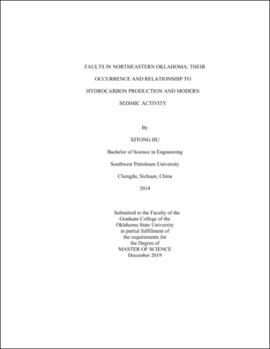| dc.contributor.advisor | Puckette, Jim | |
| dc.contributor.author | Hu, Xitong | |
| dc.date.accessioned | 2020-06-29T17:39:45Z | |
| dc.date.available | 2020-06-29T17:39:45Z | |
| dc.date.issued | 2019-12 | |
| dc.identifier.uri | https://hdl.handle.net/11244/324925 | |
| dc.description.abstract | This study examines known fault systems in northeastern Oklahoma, analyzing their relationship to producing reservoirs and their link to the recent increase in seismic activity. By collecting fault information from previous publications and unpublished industry maps, this study, using GIS techniques, compiled a detailed fault map for northeastern Oklahoma, including the type of faulting, where possible. The Nemaha, West Stillwater — Ramsey — Labette, Wilzetta, and Keokuk fault zones are the more prominent in the area of study; characterized by highly faulted networks that show a conjugate pattern and an almost orthogonal pattern. Although most faults in northeastern Oklahoma are reported to be normal in terms of apparent displacement, high-angle reverse faults have been mapped along the major fault zones. During multi-tectonic events, strike-slip displacement is an essential component for the fault systems in north-central Oklahoma. | |
| dc.description.abstract | A comparison of the age of the producing reservoirs maps with the interpretive fault map reveals that the predominance of production from Lower Paleozoic reservoirs is from structure-related traps. There is significant production from stratigraphic traps in Pennsylvanian reservoirs. It seems clear that Pennsylvanian and Permian producing reservoirs reflect reactivation of pre-existing faults and vertical migration of hydrocarbons through faults to shallower reservoirs. | |
| dc.description.abstract | A comparison of the distribution of earthquake foci with the fault map and the top of basement in northeastern Oklahoma shows that the majority of earthquakes have occurred well below the basement and that most of these earthquakes occurred between the major fault systems. The three earthquakes with moment magnitudes (Mw) of 5.0 or greater occurred quite near major fault zones, but apparently along their individual branches. | |
| dc.format | application/pdf | |
| dc.format | application/vnd.ms-excel | |
| dc.format | application/vnd.dbf | |
| dc.format | application/vnd.shp | |
| dc.format | application/vnd.shx | |
| dc.format | application/x-ogc-cpg | |
| dc.format | application/x-anjuta-project | |
| dc.format | application/vnd.sbn | |
| dc.format | application/vnd.sbx | |
| dc.language | en_US | |
| dc.rights | Copyright is held by the author who has granted the Oklahoma State University Library the non-exclusive right to share this material in its institutional repository. Contact Digital Library Services at lib-dls@okstate.edu or 405-744-9161 for the permission policy on the use, reproduction or distribution of this material. | |
| dc.title | Faults in northeastern Oklahoma: Their occurrence and relationship to hydrocarbon production and modern seismic activity | |
| dc.contributor.committeeMember | Shelton, John | |
| dc.contributor.committeeMember | Gong, Jingyao | |
| osu.filename | Hu_okstate_0664M_16595.pdf | |
| osu.accesstype | Open Access | |
| dc.type.genre | Thesis | |
| dc.type.genre | Geodatabases | |
| dc.type.material | Text | |
| dc.type.material | Dataset | |
| dc.subject.keywords | earthquake | |
| dc.subject.keywords | fault database | |
| dc.subject.keywords | oil & gas | |
| thesis.degree.discipline | Geology | |
| thesis.degree.grantor | Oklahoma State University | |
